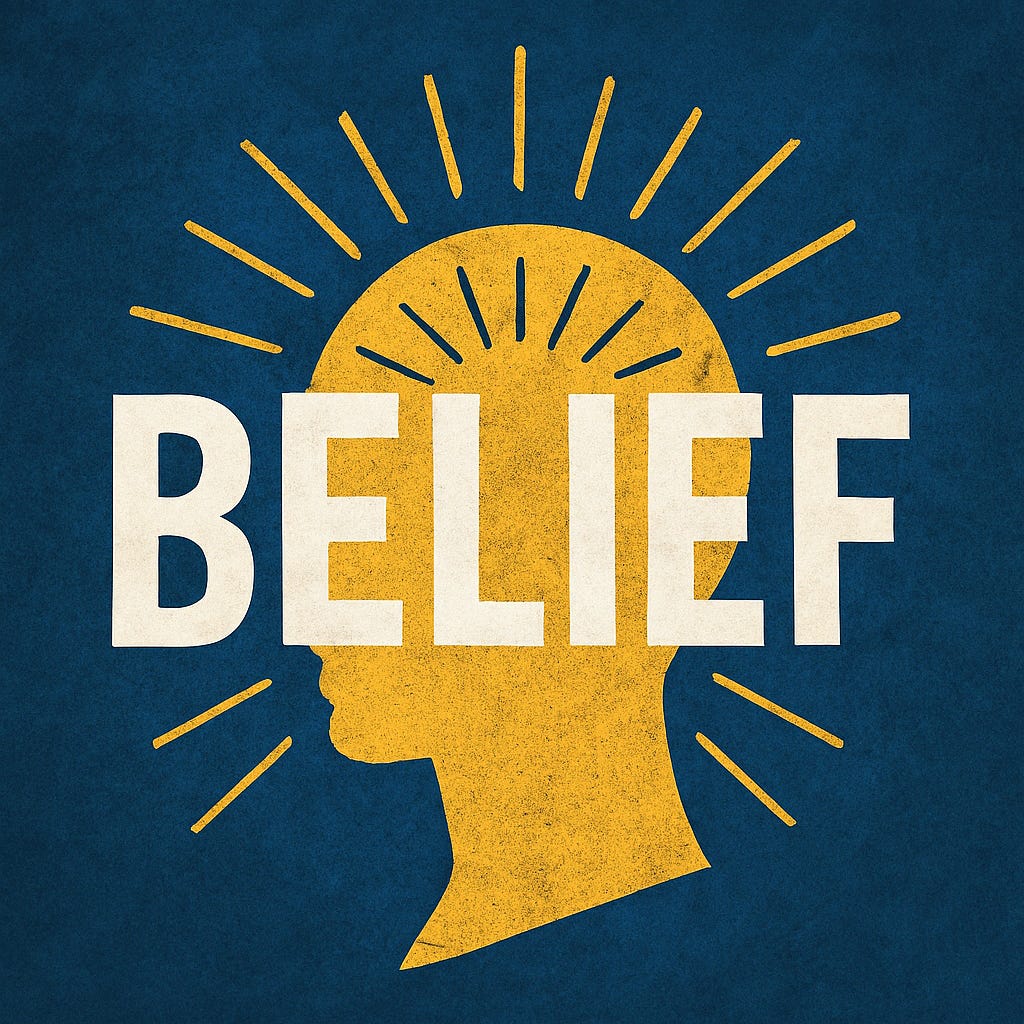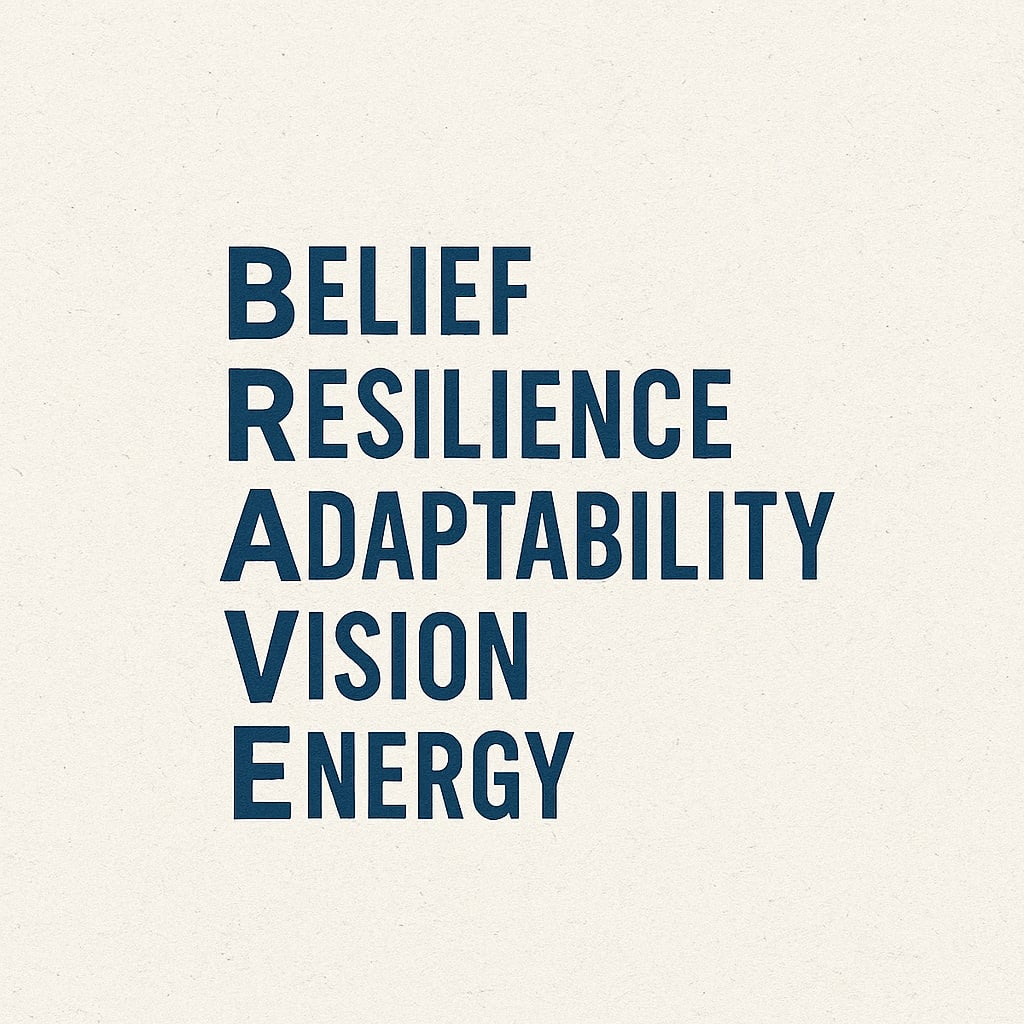A Deep Dive into Belief
In high performance environments whether it’s sport, business, or personal development exists a powerful internal resource that consistently sets apart those who rise to the occasion: belief.
Belief isn’t a vague sense of optimism or blind faith. In the BRAVE Performance method, belief begins with an intentional, trained conviction that you have what it takes to succeed in the moment. It is a foundation upon where the other pieces of the BRAVE puzzle of resilience, adaptability, vision and energy are built. Without belief, there isn’t the psychological glue that holds performance together when under pressure.
Belief in a performance environment is heavily intertwined with the concept of self-efficacy. Described as the belief in one's capabilities to organise and execute the actions required to manage situations (Bandura, 1977). This theory has been widely applied in sport, education, and leadership to explain why individuals with similar abilities often perform differently. The difference isn’t talent, it’s belief.
According to Bandura (1997), an individuals belief or self-efficacy will influence whether they think in self-enhancing or self-defeating ways, how much effort they expend, how long they will persist in the face of obstacles and how resilient they are to failure. In the BRAVE method, I believe belief can be cultivated. And it begins by building evidence of effort and progress that builds into proof. Small wins reflect progress and reinforcement of the hard things we’ve done before. This track record of performance contributes to a mindset capable of facing high stakes moments. And this evidence allows the individual to tackle challenges with composure and conviction.
The research on self efficacy is also backed by robust findings within in sport psychology. A meta-analysis by Moritz et al. (2000) confirmed that self- confidence closely aligned with self-efficacy and has a moderate to strong correlation with athletic performance across a wide range of disciplines. Confidence, however, isn't built overnight. It’s formed through planning, deliberate practise and evaluation. All key aspects within performance environments and necessary to cultivate belief.
Another key component to harnessing belief is visualisation. Also a key component of vision within the BRAVE method, which we will delve deeper into in future articles focusing on vision. Briefly, visualisation is the concept of mental rehearsal with research showing that visualising successful performances can activate regions in the brain which show a similar effect to that of physical training (Guillot & Collet, 2008). Athletes, musicians, and high performers often use visualisation to ‘prime the mind’ for execution, creating a powerful sense of familiarity and certainty. In BRAVE, belief is strengthened through looking back at the evidence built in previous work and also by mentally rehearsing what’s ahead and seeing yourself succeed.
How we interpret our successes and failures becomes a feature of cultivating belief. If we can see our successes as a result of our own effort or strategy, we are more likely to stay motivated and confident when inevitable challenges arise. If we view failure as a result of personal inadequacies or place the blame on factors outside our control we can easily erode belief which may lead to a sense of helplessness. The BRAVE method promotes a growth oriented perspective, encouraging us to treat setbacks as valuable feedback or signals that something can be adjusted or improved. Belief also interacts dynamically with resilience and adaptability, two other pillars of the BRAVE method. When belief is strong, setbacks become manageable, even motivating. High self efficacy enhances our resilience to stress. This allows individuals to remain emotionally stable during high pressure moments. Most performance environments are dynamic, plans can change, outcomes are uncertain. Belief becomes your anchor.
In team settings, belief becomes contagious and helps build connection. Collective efficacy, the group’s shared belief in its capability to perform, is another strong predictor of success. Group leaders should instill belief through constructive feedback, modelling composure and reinforcing effort over outcome to create high performing teams and team cultures. We often hear of successful sports coaches talk of their teams connection with each other, these teams have harnessed a collective belief, which allows them the confidence to be courageous in the most challenging moments. Using the BRAVE method these coaches and leaders build belief through intention, repetition, and connection.
Other BRAVE strategies to cultivate belief:
Track Progress Deliberately – Keep evidence of growth visible. Preparation, repetition, and reflection builds a case for confidence.
Reframe Setbacks – Practice constructive internal dialogue. Instead of “I failed,” shift to “That didn’t work, how can I try differently?”
Visualise Success Repeatedly – Mental rehearsal improves readiness and confidence. See it clearly before you do it physically.
Anchor to Purpose – Belief becomes more powerful when it’s tied to why you want to perform. A deep purpose sustains belief in hard moments.
Surround Yourself Intentionally – Align yourself with people who believe in you, reflect your strengths, and challenge you. The social reinforcements strengthen our personal resolve.
Belief is not a luxury in reaching high performance. It’s an absolute requirement. It’s the psychological ground on which you stand on when things become uncertain. Within the BRAVE method belief is arguably the most critical piece because it fuels every other part of the journey. With belief, resilience grows stronger. Adaptability feels safer. Vision becomes sharper. And energy becomes more intentional.
You can’t wait for belief to appear on its own. You must build it.
Send me a message if you’d like to work with me on your mental strategies for performance.
Bandura, A. (1977). Self-efficacy: Toward a unifying theory of behavioral change. Psychological Review, 84(2), 191–215.
Bandura, A. (1997). Self-efficacy: The exercise of control. Freeman..
Moritz, S. E., Feltz, D. L., Fahrbach, K. R., & Mack, D. E. (2000). The relation of self-confidence and performance across sport types: A meta-analysis. Journal of Sport and Exercise Psychology, 22(3), 446–456.
Guillot, A., & Collet, C. (2008). Construction of the motor imagery integrative model in sport: a review and theoretical investigation of motor imagery use. International Review of Sport and Exercise Psychology, 1(1), 31–44.



